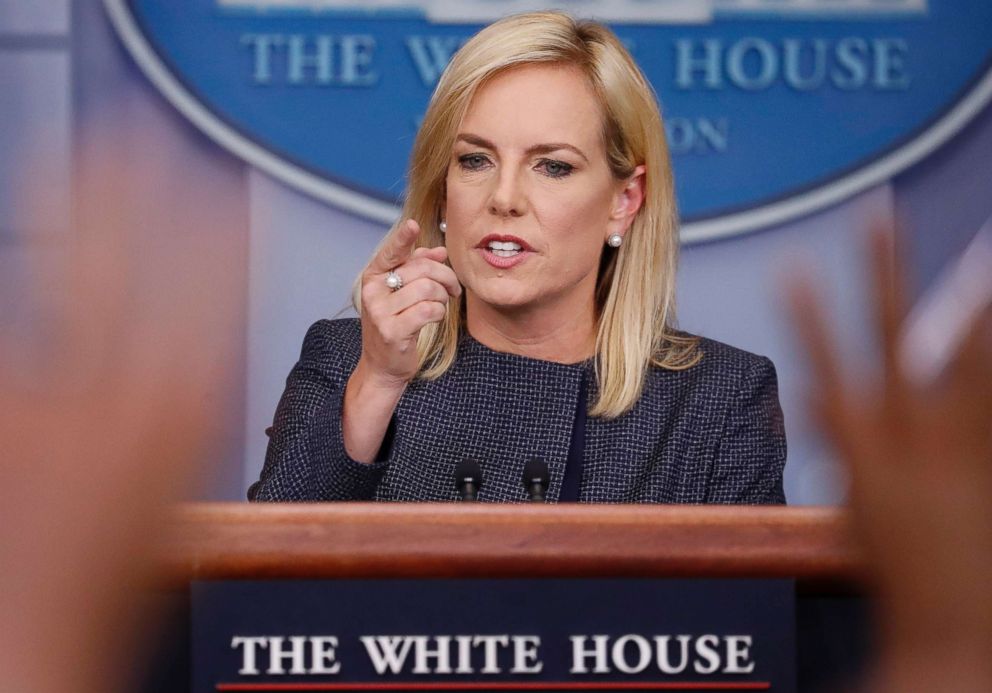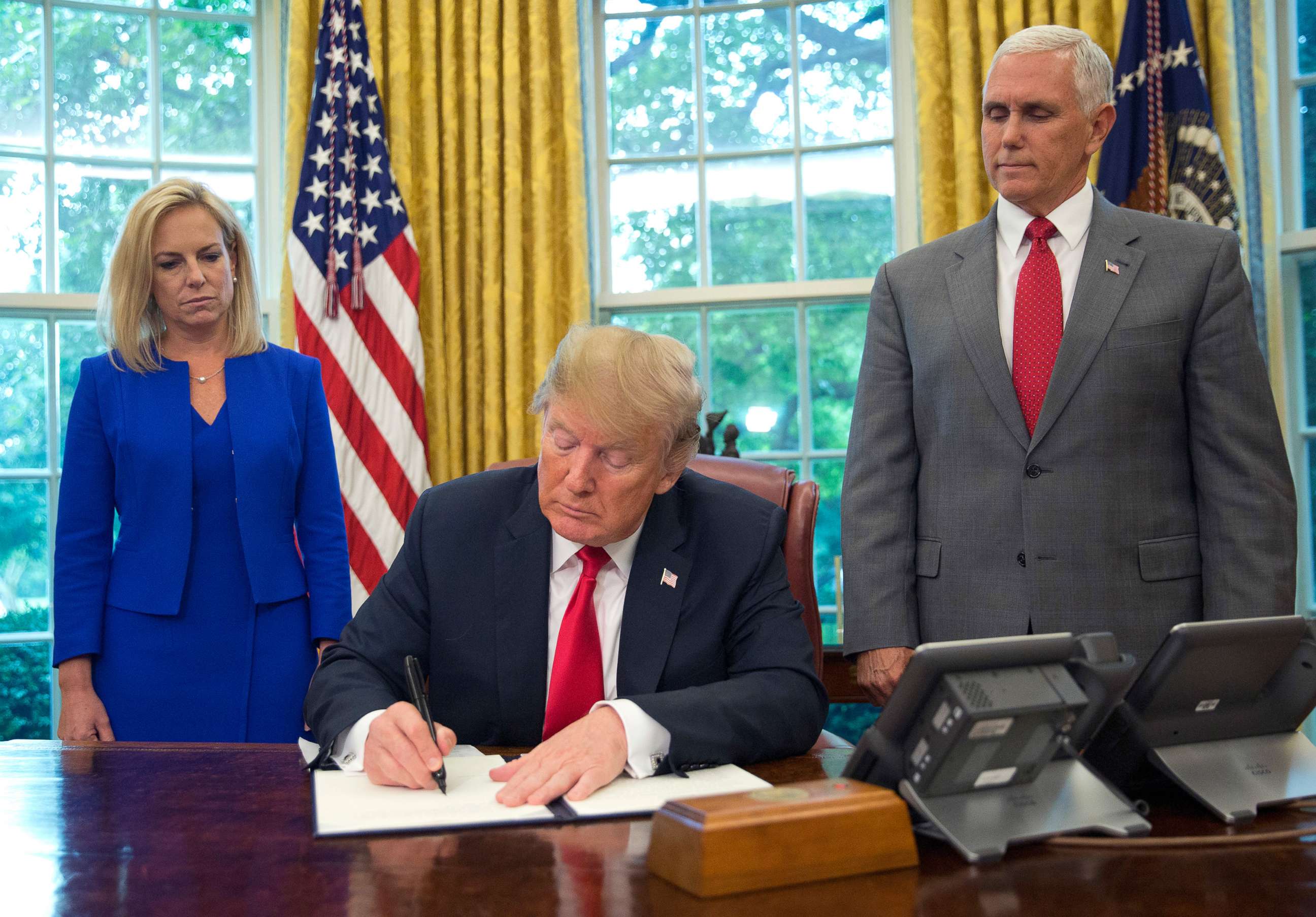Migrant mistruths and more: FACT CHECK FRIDAY
The week was dominated by false claims involving the immigration crisis.
This was not intended to be a weekly segment. But since ABC News started its FACT CHECK FRIDAY four weeks ago, the mistruths, falsehoods and misleading statements from President Trump and his administration seem to be only increasing in frequency.
Care to check that statement? See how the Washington Post zeroed in on the trend.
This past week was dominated by news of a backlash the Trump administration faced over its decision to separate migrant children from their parents at the border. After pressure mounted from within his own party – and even his own family – the president caved on Wednesday and reversed course, ending the controversial practice by executive order.
His frustration was on full display this week, manifested in large part in a series of false claims. ABC News confronts those statements by him and others in his administration in our fourth... FACT CHECK FRIDAY:
1.) Crime in Germany is "way up"
When the president tweeted Monday that the crime rate in Germany is "way up" as part of his message to Germans that it was a "big mistake" to allow an influx of immigrants that "strongly and violently changed their culture," many pointed out that his crime stats were wrong.
So did the president correct himself? No, he just said it again.
"Crime in Germany is up 10% plus (officials do not want to report these crimes) since migrants were accepted," Trump tweeted on Tuesday. But that statement is not supported by any available statistics.
In fact, the available evidence says it's the opposite. According to the most recently released German government data the crime rate in 2017 dropped by 5.1 percent compared to the previous year, excluding immigration offenses like illegal border crossings. And if immigration-related offenses are included, the crime rate has decreased even more – by 9.6 percent.
The White House never provided any evidence to support President Trump's claim.

2.) It's not a deterrent
As the controversy over separated migrant families seemed to reach its boiling point Monday, Homeland Security Secretary Kirstjen Nielsen told reporters at the White House the policy was not meant to send a message to people considering entering the United States illegally. In fact, Nielsen said she was offended by any such suggestion.
REPORTER: Thank you very much. Are you intending for this to play out as it is playing out? Are you intending for parents to be separated from their children? Are you intending to send a message?SECRETARY NIELSEN: I find that offensive. No. Because why would I ever create a policy that purposely does that?
Nielsen says the policy was designed to close loopholes that could allow undocumented immigrants to stay in the U.S. indefinitely, not as a deterrent. But her comments stand in direct contradiction to statements from no fewer than three senior administration officials.
In May, just after the zero-tolerance policy was announced, White House chief of staff John Kelly told NPR that family separation would serve as a "tough deterrent." And last year, when he served in Nielsen's position, he told CNN he was considering the policy as a deterrent measure.
Even Attorney General Jeff Sessions, the official responsible for announcing and enforcing the measure, told Fox News that "hopefully people will get the message and come through the border at the port of entry and not break across the border unlawfully.”
And one day after Nielsen's comments, Steven Wagner, the principal deputy assistant secretary at the Department of Health and Human Services and its Administration for Children and Families, told reporters on a conference call that officials "expect that the new policy will result in a deterrence effect."

3.) “You can’t do it through an executive order”
During an impromptu and extremely fact-challenged encounter with the press last Friday in front of the White House, President Trump falsely claimed his policy of separating migrant children from their parents could not be solved with an executive order.
“You can’t do it through an executive order,” he told ABC News' Kenneth Moton. But by Wednesday of this week, facing mounting political pressure, he did just that and signed an executive order to end the controversial practice. And he's not the only one who said the White House was unable to act.
On Monday, Homeland Security Secretary Nielsen said it was up to Congress alone.
"Until these loopholes are closed by Congress, it is not possible as a matter of law to detain and remove whole family units who arrive illegally in the United States, Nielsen said in the White House briefing room. "Congress and the courts created this problem, and Congress alone can fix it.”
And White House communications adviser Mercedes Schlapp told reporters outside the West Wing on Tuesday morning. “At the end Congress has the power to fix this, we’re just executing the law.” Those statements have proven to be untrue. Oh, and the president tweeted Friday that Republicans in Congress should "stop wasting their time" on an immigration bill.
4.) "This will solve that problem"
When President Trump signed the executive order Wednesday to halt the separation of immigrant families at the border, he boldly proclaimed that the issue – with just the stroke of his pen – was solved. "We're keeping families together and this will solve that problem," the president said.
But at this point, it's too early to tell if this is true. The executive order does not address the uniting of families already separated, and so the immediate fate of those 2,300 immigrant children – the images of which have roiled the nation over the last week – is still up in the air.
Trump weighed in on the matter during a Cabinet meeting on Thursday and said he was directing HHS, DHS, and DOJ to "work together to keep illegal immigrant families together during the immigration process and to reunite these previously separated groups." Yet the Department of Health and Human Services says it is still awaiting "further guidance" about reunification.
Here's what we do know: In the wake of the executive order, as of Friday, at least 500 of the more than 2,300 children that have been separated from their parents since the "zero tolerance policy" went into effect have been reunited with their parents, according to an administration official who was not authorized to speak on the record.
The Department of Homeland Security has also stopped referring members of family units to the Department of Justice for prosecution. Despite this, the administration still appears to be in a state of confusion and details on what they plan to do and how they plan to do it are scant. And thousands of immigrant children are still waiting to be reunited with their families.
5.) “Total denuclearization...has already started taking place”
At Wednesday’s “Make America Great Again” rally in Minnesota, President Trump bragged – and stretched the truth -- to his supporters about the concessions he received from North Korea’s Kim Jong Un at the Singapore summit. “Sentence one says ‘a total denuclearization of North Korea,’” Trump told the crowd of his joint agreement with North Korea's dictator. “There will be denuclearization...So that’s the real story.”
Clearly, that's the hope, but it certainly has not yet qualified as fact.
But the president didn't stop there. During a Cabinet meeting on Thursday, he declared "And the big thing is, it will be a total denuclearization, which has already started taking place.”
Yet according to his own Defense and State Departments, that's not true. When asked if there were any military indications that North Korea has done anything to denuclearize, Defense Secretary Jim Mattis flat-out contradicted his boss. “I’m not aware of any,” he said to reporters on Wednesday. “Obviously, we’re at the very front end of the process, the detailed negotiations have not begun. I wouldn’t expect that at this point.”
And in a Thursday briefing, State Department spokeswoman Heather Nauert was questioned about progress in North Korea. “I don’t have anything to share with you on that,” she said.
North Korea appeared to destroy part of a nuclear test site in late May using controlled detonations, but only journalists were invited to observe, not nuclear experts who could verify whether the facility is still functional.
ABC News' Mariam Khan, Jordyn Phelps Benjamin Siegel, and Elizabeth Brown-Kaiser contributed to this fact-check.




